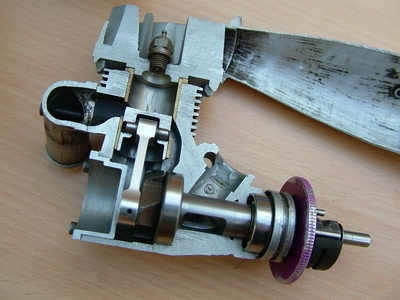
Cylinder head porting is an automotive machining processes that the average hot-rodder can do at home. Porting involves using an assortment of grinding and cutting bits to reshape or polish the cylinder head's intake and exhaust ports, and combustion chamber roofs for increased airflow and efficiency. A good port job is mostly a function of having detailed information on your cylinder heads and using the right tools to work them.
A die grinder is kind of like a high-speed, high-powered drill. However, most die grinders don't use a handle perpendicular to the bit as drills do. Your grinder can be air- or electric-powered; it all depends on what you favor and what you have to work with. Air grinders are smaller, easier to maneuver and run cooler, but require a powerful air compressor. Electric grinders are big, hot, loud and heavy but are more powerful and plug into the wall.
A mandrel is to a die grinder as an extension is to a ratchet. Mandrels are essential for reaching deep into intake and exhaust ports for re-working the top of the short-side turn radius. The short-side turn is where the port begins to curve down toward the valve, and its shape plays a role in determining airflow.
Porting is primarily a cutting operation--not a grinding one. Keeping your bits well lubricated with lightweight machine oil, or a penetrating oil like WD40, PB Blaster or Liquid Wrench, will keep the bit cool and sharp for hours of extended use. A constant flow of lubricant is essential when porting aluminum, which tends to melt and clog the bits.
These are your primary cutting tools. These fairly expensive but specialized bits utilize nearly diamond-hard metal to keep their edge after hundreds of hours of use, and come in a variety of shapes and sizes. The 3/8-inch diameter cylindrical, oval-tipped and tree-cut bits are the workhorses of this bunch, but you can use flame-cut and spherical bits to get into tight spaces.
Grinding stones are less aggressive than carbide bits and can leave a smooth finish, but they wear down fairly quickly and don't work well with aluminum. Grinding stones don't work well with oil lubricant, but without this lubricant, aluminum will quickly clog the stone's pores.
Cartridge rolls are small loops of sandpaper that fit over a "drum" on the grinder bit. They are available in a wide variety of abrasiveness (grit) and sizes, and are cheaper and quicker to replace than grinding stones. The only advantage that stones have over rolls is that stones can come in a variety of shapes to reach tight areas; cartridge rolls are cylindrical only.
A flapwheel is comprised of dozens of small rectangles of sandpaper attached to a central hub. Flapwheels are ideal for final shaping and polishing since they have a bit of give to conform to contours and curves inside the cylinder head. Flapwheels come in a variety of grit ratings and sizes.